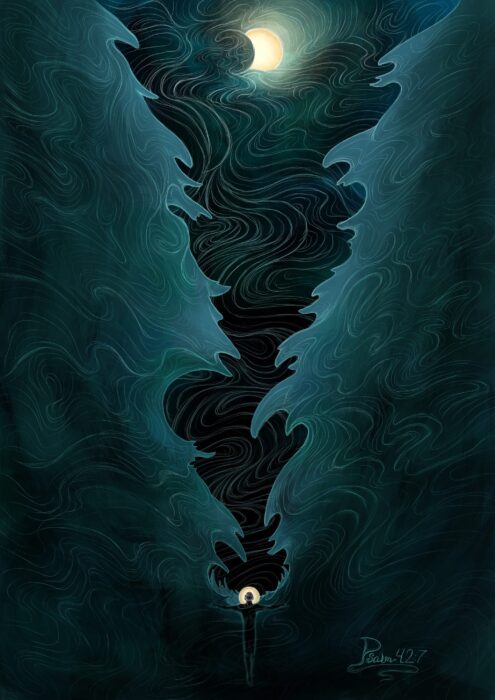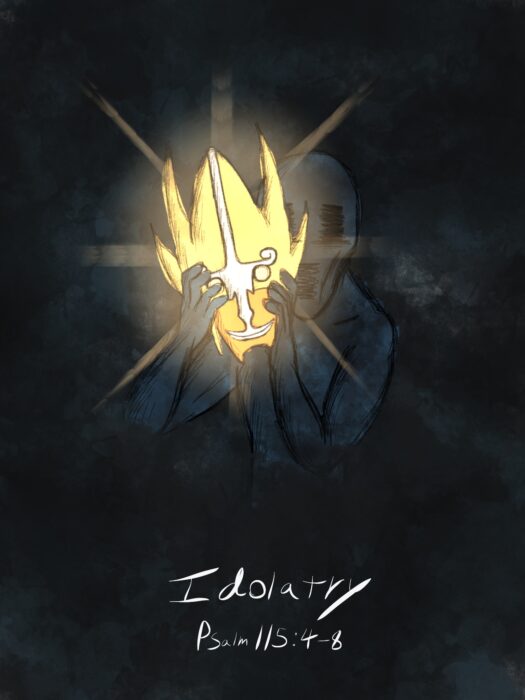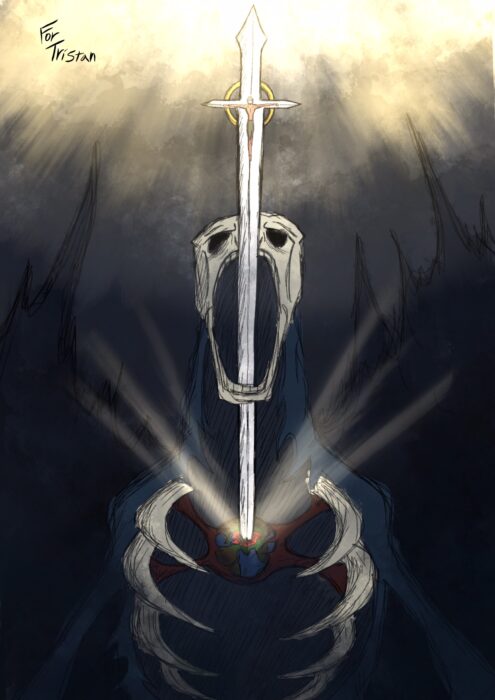The Passage Explained
Psalm 42/43 is a poem of lamentation and hope comprised of 3 stanzas. The first stanza establishes that the Psalmist is in spiritual agony because he is far from the presence of the Lord and surrounded by those who oppose YHWH (42:1-6a). In the second stanza, the author affirms that YHWH Himself is ultimately in control even of this suffering and so he pours out a faith-born prayer of desolation to the God of His life asking “why have you forgotten me” (42:6b-11)? Finally, with the third stanza the Psalmist appeals with confidence for God to lead him with sovereign grace back to the joy-giving presence of the Lord (43:1-5).
This Psalm follows a pattern of poetic lament that is common throughout the Psalter. In the first section the lament is expressed, in the second it intensifies and the eyes of faith turn to YHWH, and in the third faith blooms to hope which bears the fruit of worship, even in the midst of darkness. Our verse is found near the center of the second stanza, in perhaps the darkest point of the Psalm.
“Deep calls to deep at the roar of your waterfalls; all your breakers and waves have gone over me.”
The first thing to note here is the pronounced use of water imagery: deep, waterfalls, breakers, waves. All of these things conjure up imagery of the wild, untamed ocean—the “abyss.” The Israelites were not seafaring people and were generally frightened of the ocean’s chaotic darkness. Accordingly, much of the oceanic imagery in scripture carries a negative connotation, and—especially significant for our purposes—could function as a picture of God’s judgment or wrath (Psalm 88:7, Jonah 2:3). Notice also that the watery ordeal of Ps.42:7 is flowing from YHWH. They are “your waterfalls,” and, “your breakers,” and, “your waves”. In verse 1 we read that the psalmist longs to come to God as a deer to gently flowing streams, but in verse 7 it’s as if the stream has flooded and become a raging sea. Rather than comforting his weary soul, the Lord’s sovereignty has brought hardship and seems ready to drown him.
However, even under this hard providence, the psalmist does not lose faith. The day and night imagery of verse 8 seems to imply that YHWH remains the same in both the “days” of our sweet seasons and the “nights” of our affliction. He has not abandoned His own when darkness falls, rather, His song remains with them. And what is this song in the night? Verses 8 and 9 imply that the psalmist’s “song” is the God-given faith and motivation to cry out to God in prayer.
The fact that the appeal to God found in vs.9-10 begins by calling God “my rock” and assumes a personal connection between God and the supplicant (“why have you forgotten me?”) points to desperate faith—rather than hopelessness—as the motivating principle. This is affirmed by the repetition of Psalm 42/43’s hope-filled refrain in verse 11. Though the darkness descends most heavily in this central stanza, light breaks through in the end and the Psalmist concludes with a song of afflicted, but not crushed, faith.
Psalm 42:7 and the Cross
Before moving on to explain the picture, I want to mention something about how we are to read this Psalm through the lens of the cross. Ultimately, I believe that every Psalm is about Jesus (Luke 23:44, John 5:39-40). They are the songs of the saints only because they were first the songs of the Son; unfolding His heart, exalting His person, explicating His work. Psalm 42:7 is no exception. How, then, are we to understand these words as the “song” of Christ? There are at least two ways, the first is textual, and the second is thematic.
A Textual Link
The textual link to Christ is seen most clearly by noting the similarities between Psalm 42:7 and Jonah 2:3,
“For you cast me into the deep, into the heart of the seas, and the flood surrounded me; all your waves and your billows passed over me.” – Jonah 2:3
“Deep calls to deep at the roar of your waterfalls; all your breakers and waves have gone over me.” – Psalm 42:7
The underlined portions are identical in Hebrew, which I take as warrant to read these two texts in light of one another. Jonah’s poetic description of his own “death” under God’s wrath (and his subsequent “resurrection”) seems to intentionally draw on the imagery of Psalm 42:7. This is significant because Christ Himself links His true death and resurrection to the Jonah narrative (Matthew 13:39-40), and—by implication—to Psalm 42:7. Jesus was saturated in the Hebrew Scriptures and so the connection between Jonah’s descent into the depths of the sea and the Psalmist’s lament in 42:7 would not have been lost on Him. It seems to me, then, that our Lord Himself invites us to read 42:7 in light of His own sufferings on the cross.
A Thematic Link
But secondly there is a thematic connection. On the cross Jesus bore the sins of His people from all places and ages, together with all the sorrow, suffering, and divine punishment that these sins entail. We cannot find a single lament in the Psalms that Israel’s Messiah does not inhabit in His passion. Psalm 42 is no exception. The agony of being cut off from God’s presence is one that Jesus experienced to its infinite limit in His dying hours on Calvary, and His suffering was intensified by the knowledge that, as the Psalmist tells us, it was God’s waves and God’s breakers that passed over the beloved Son as He died.
Might this not give us an idea of what is bound up in the call of “deep” to “deep” in Psalm 42?
“And about the ninth hour Jesus cried out with a loud voice, saying, ‘Eli, Eli, lema sabachthani?’ that is, ‘My God, my God, why have you forsaken me?’” – Matthew 27:46
At the cross the eternal Son is lifted up, exalted as the bearer of our curse, and is drowned under the sea of wrath that we deserved. And in that moment of greatest conceivable agony, the infinite Deep of the Son’s heart cries out in dereliction to the infinite Deep of the Father’s heart, and the Spirit—the bond of their union—resonates between the two as love embraces wrath; the harmony of our redemption (Hebrews 9:14). “Deep calls to deep” and we are saved.
But if verse 7 echoes Christ’s wrath-bearing death, Psalm 42/43 goes on to anticipate the hope of His resurrection. As mentioned above, in verses 8-11 the Psalmist continues to hope in YHWH as his covenant Lord even in the face of his sufferings. We see the same with Jesus. The dereliction that Christ endures as He swallows our god-forsakenness on the cross is real and final. However, since He is both man and God, He can endure and exhaust this horror in Himself. Thus the cry of desolation—like the Psalmist’s song in the night (42:8-11)—both embraces the suffering of the present and looks beyond to future hope in God (as does the narrative arc of Psalm 22, from which Christ’s cry is drawn). As He finished His work on the cross, Jesus placed Himself into the hands of the covenant-making, covenant keeping God of Israel, knowing that—by His covenant faithfulness—YHWH would not let the Messiah see corruption, but would raise Him from the grave and bring Him to God, to His exceeding joy (Hebrews 13:20, Psalm 16:10-11, 43:3-4).
The Picture Explained
In this image the darkness and waves all but engulf the floundering sufferer framed at the bottom of the scene. Both the man’s size and position are intended to evoke the sense of abandonment and desperation we hear from the Psalmist in 42:7. However, standing over all the darkness and chaos of the storm is a single point of not-quite-eclipsed light. This light—which is in the sufferer’s direct line of sight—alludes to the hope that the Psalmist clings to even in his separation from the Lord’s presence (42:8-11). Though it is night, YHWH still gives His covenant-people a song, a prayer to their God that ends with the hopeful refrain, “I shall again praise Him, my salvation and my God.”
Of course, we have this hope in the midst of our suffering only because Christ has gone before us. We know that God will not forsake us, even in our darkest night, because Jesus bore our final god-forsakenness on the cross. The cruciform posture of the sufferer points to the fact that Jesus is ultimately the one who bears the waves and breakers of God’s wrath, and the light of hope is in the form of an opened tomb because Christ’s hope on the cross—and our hope in Him—was that, after being submerged in the waters of death, He would be raised by the glory of the Father (Rom.6:4).




